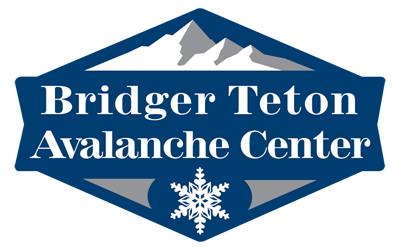More Info
Welcome to Snowpack Tracker for the Bridger-Teton Avalanche Center (BTAC)
Data View Options
Snowpack Tracker
Displays BTAC 24-hr data (or "white sheet" data). Default view is for the previous 30 days, with the ability to view historic seasons back to 1974-75.
Storm Tracker
Display defaults to hourly weather station data for the previous 48 hrs, with data viewable for the previous 14 days. Weather stations are located throughout the BTAC forecast areas, with data latency of ~30 min (e.g. observations for 7:00 AM will be displayed by 7:30 AM for most stations). A map displaying BTAC weather station locations is available here. All panels display raw hourly data, except wind speed (ave and max for previous hour) and precipitation (sum for previous hour). Use the interactive legend to toggle individual stations on/off.
Region groups correspond to the BTAC forecast zones. Elevation groups do not correspond to hazard rating elevation zones, but instead are grouped as "Low" (valley floor stations <7,000'), "Mid" (precip and wind stations ranging 7,800'-9,800'), and "Upper" (wind stations >10,000' for viewing 700mb wind and air temps).
Event Radial Plot
Displays avalanche events plotted on an aspect/elevation rose diagram. Markers are colored by crown depth and sized by relative size. The interactive table displays all event metadata for the selected time range and checkbox filters. Table columns are sortable, and single or multiple events selected from the table are highlighted on the plot.
Data Sources
Storm Tracker data is sourced from the Synoptic Data API.
Snowpack Tracker and Event Radial Plot display derived or manually recorded data sourced from snow study plots and weather stations at Jackson Hole Mountain Resort (JHMR), including Rendezvous Bowl plot (9,580'), Raymer plot (9,360'), Mid-Mountain plot (8,180'), and Rendezvous Summit (10,450'). This dataset has been maintained by the BTAC and JHMR Ski Patrol since the late 1960s. Details for each Snowpack Tracker panel are below:
Hazard Rating
Avalanche hazard ratings are posted daily by BTAC forecasters, using the North American Avalanche Danger Scale, with the following color code:
- White: No hazard rating issued
- Green: Low hazard
- Yellow: Moderate hazard
- Orange: Considerable hazard
- Red: High hazard
- Black: Extreme hazard
Teton area hazard ratings are displayed for three elevation zones: Low (6,000' - 7,500'), Mid (7,500' - 9,000'), High (9,000' - 10,500')
Avalanche Events
Events submitted by the public or recorded by BTAC forecasters are color-coded for crown depth. Note that crown depth is often estimated by observers. 'Area' includes events from avalanche control work at Jackson Hole Mountain Resort, and 'BC' is all recorded backcountry events. Many avalanches occur during periods with limited visibility and/or in remote locations and are not observed or reported.
New Snow, SWE, Snow Depth, and Settlement
Snow depth is manually measured from a total snow depth stake, and 24-hr new snow and snow water equivalent (SWE) are measured using a SnowMetrics density tube. Measurements represent previous 24-hr totals, and are taken at approximately 10 AM daily. SWE is displayed as SWEx10 to enable quick estimation of new snow density. For example, new snow and SWEx10 bars of equal height represent 10% density. Settlement is calculated as [total depth previous day] + [24-hr new snow] - [total depth current day].
SKY and SH/NSF
SKY conditions and the presence (Yes or No) of surface hoar / near-surface faceting are based on observations from BTAC forecasters, and represent general conditions for the Teton forecast area. SKY condition follows standard SWAG codes.
Cumulative SWE
Calculated from 24-hr measured SWE, using rolling cumulative sums over the specified window length.
New Snow Density
Calculated from 24-hr new snow and SWE values, and represented as a unitless fraction following standard SWAG methods.
Air Temp
Includes minimum and maximum values during the previous 24 hrs (5am - 5am).
Wind Speed and Direction
Includes previous 24-hr (5am - 5am) average wind speed, wind direction, and maximum gust. Wind direction vectors indicate the compass direction the wind is from. Recorded at Rendezvous Summit and the Raymer wind station (located on the Headwall ridge above the Raymer Plot). Note: wind direction vectors are best viewed for time ranges of ~3 months or less.
FAQs
Where can I get the raw data?
Visit Synoptic Data to learn more about the Mesonet API services, which provide access to surface weather data across North America and globally. For more information on avalanche events and hazard data, contact the Bridger-Teton Avalanche Center.
Can a version of this web application be designed for my forecast center or highway avalanche control operation?
Yes! We have intentionally designed Snowpack Tracker to be transferable to additional regions by leveraging generalized templates and standardized weather data from the Synoptic API. Contact Patrick Wright (pwright@inversionlabs.com) or Tobey Carman (tcarman@inversionlabs.com) for additional information. Visit us at inversionlabs.com.
What software tools do you use?
This web application is written primarily in Python, using Pandas, Bokeh and Flask. Huge thanks to the core developers and open-source community that support these tools!
 © 2017- Display built by Inversion Labs
© 2017- Display built by Inversion Labs
